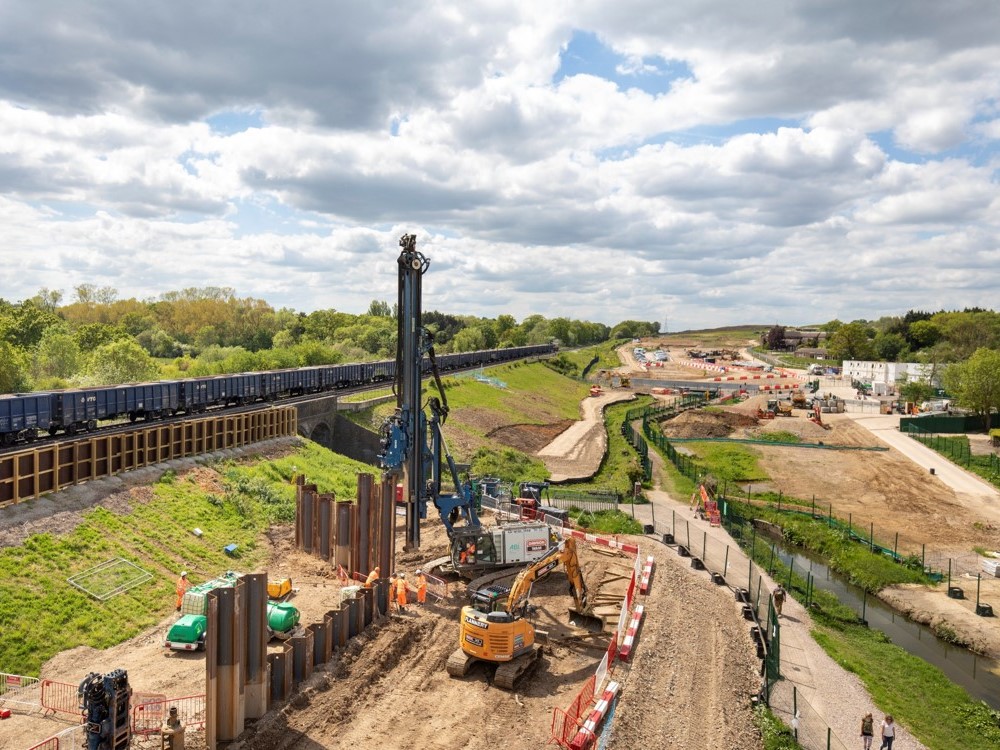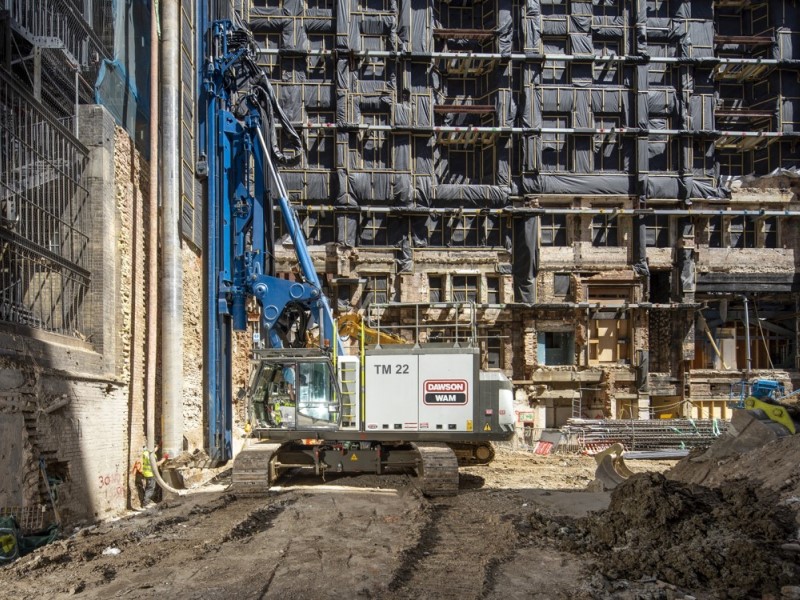London: M4 J3-12 Smart Motorway
PROJECT DETAILS
CLIENT:
Highways England
DESIGN ENGINEER:
Arcadis Jacobs JV
MAIN CONTRACTOR:
Balfour Beatty Vinci JV (BBV)
PROCUREMENT ROUTE:
NEC 3rd Edition Option C
LOCATION:
London to Reading
Dawson-WAM (DW) were contracted by Balfour Beatty Vinci joint venture (BBV) to provide all the sheet piling and associated works on the M4 Smart Motorway Project. This involved early specialist involvement to provide to solutions to complex challenges.
The upgrade to a smart motorway involved works over a 32-mile section of the M4 motorway. DW’s works will be completed in mid-July 2021 completing a total of 6km of permanent sheet piles retaining walls on the motorway network and a further 1.2km around the structures, side roads and culverts.
Dawson WAM’s works centred around permanent retaining walls for both the SMP works on the motorway network itself (mostly KSP walls) as well as continuous walls on the side roads and around the new bridge approaches.
This included 10 new message signs, 131 new gantries, replacing 11 existing bridges, widening 4 bridges and expanding 4 subways.
The works for Dawson WAM began at the beginning of June 2019 but we were involved collaboratively assisting the JV where possible in the preceding period of 2016-2019 on temporary works solutions primarily associated with the new bridges.
Sheet piles were delivered to site in a just in time basis throughout this project. Piles were ordered from supplier as per design and delivered to DAWSON-WAM’s 13 acre Bedfordshire yard where they were stored until required. Having the benefit of a storage facility allowed for a greater control over sheet piles and benefited the collaborative design approach which was taken throughout the scheme in order to save costs and mitigate material wastage.
DWL’s motorway works initially centred around Jct 8/9 – Jct 12 walls where the JV was able to VE a lot of the embedded wall solutions to earthworks solutions. The focus of the VE works for the works in June 2019 to early summer 2020 involved temporary works sheet piling for verge retaining walls river cofferdams and temporary hollow bore grouted anchors on the larger bridge widening over the River Thames at Thames Bray
In addition, temporary sheet piles and permanent sheet piles were installed at the following bridges, Ascot Road, Huntercombe, Datchet Road, Lake end, Wood Lane, Riding Court and Marsh Lane replacement bridges.
The ensuing period of summer 2020- summer 2021 has involved the installation of permanent sheet piles walls between Jct 8/9 to Jct 3. This has involved a lot of continued collaborative working to identify and adapt the best solutions for BBV due to the large number of embankments, restricting the onsite working width of the platforms.
This has included working at night, working at weekends (to take advantage of the bridge lift closures), using specialised techniques in noise and vibration reduction where the pile line is close to adjacent services of properties and the use of DW’s steel mat system to assist heavily in platform construction and temporary works.
Collaborative Working
DW have had a large design input working closely with BBV the temporary works team to collectively find solutions to onsite restrictions and constraints. A few examples are listed below;
- Optimising sheet pile sections on SMP West (J8/9-J12) to supplement the initial purchase order piles with existing stock piles. This cut down on procurement times and developing this further within the available stock throughout the project as walls were deleted/added. This contributed to large cost savings in addition to reusing materials.
- Reviewing the initial base cofferdam design’s (from BBV) and making key suggestions to the design & develop it for global stability. This more efficient method included the use of our Steel Mat’s in addition to our own stocked pile sections. Shorter sheet pile sections were also supplied form Dawson WAM stock to install into the river using a crane suspended vibro. This wall to created a temporary silt curtain barrier which coupled up with a floating silt curtain barrier we were able to ensure no silt or contamination would pollute the River Thames. Our techniques for installing close to watercourse and high-pressure gas main meant that Dawson WAM was able to successful install the cofferdam encroaching into the River Thames with minimal disruptions to the local residents, wildlife and daily river users.
- Designing and developing hollow bore grout anchor solution/detail where the JV mechanical anchors were proving difficult to install/refusing on obstructions. These were required to support the sheet piles retaining an embankment with a 9.3m retained height on the access road to the cofferdams.
- The development of numerous sheet piled retaining walls in lieu of L shaped retaining walls at Ascot Road, Riding Court and Marsh Lane Bridge approaches. Dawson WAM’s contributed in terms of driveability and desired outputs to match the programme.
Use of High Modulus HZM Solution
Designing and developing a high modulus HZ/AZ temporary wall for a new bridge abutment. This wall was installed using preauger/water jetting methods due to being in close proximity to a high-pressure Thames Water asset
Box Piles in lieu of Steel Tubes
Proposing the use of box piles (In lieu of steel tubes) at the crossing over a high-pressure Thames Water asset. Preaugering and water jetting were also required at this location. Dawson WAM utilised their availability of a second rig to allow one rig to install and one rig to preauger subsequently increasing productivity to meet key dates.
Using Civil Engineering Expertise
Development and installation of flume pipes inside a cofferdam installed by DW which was required to reduce pumping costs, making construction simpler, and to enhance/assist aquatic life at Chalvey Culvert cofferdams.
Other Achievements
Assisting the JV in the development of reuse of temporary works materials from one structure to another
Received recognition from the JV and other contractors, most recently an award in recognition of performance that far exceeds expectations and significant contribution to the workings and progress of the project.
3D Design, Digital Rehearsal & Innovation
DW utilised the latest design technology to produce 3D models of our equipment and working areas. These models were used to plan and risk assess works in an iterative manner. Final solution drawings and sequence models were then used to inform the workforce and other interested parties on the works, highlighting risk, to achieve a right first time approach.
These detailed models as well as well as data captured as works progressed were added to a collaborative digitial model owned by the client for the future planning, risk management and ultimately a digital as built model of the works.
DW used and further developed our SafeLane CheckPoint system on the project, using Dual Sentry to manage our working area, making it safer and reducing gateman requirements.



